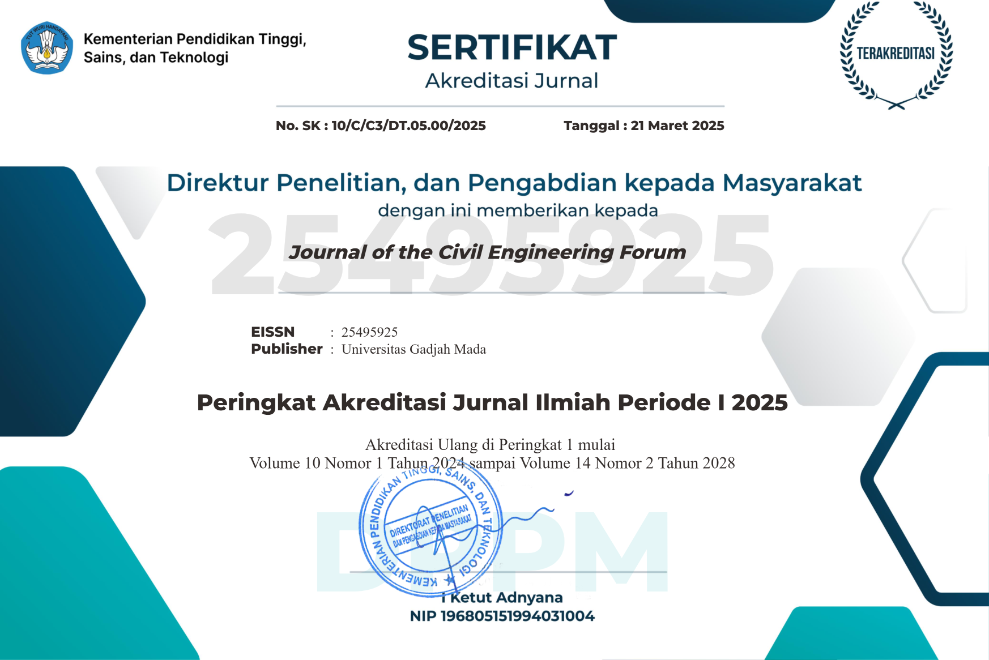SPT and CPT Correlation of Expansive Clay in Cikarang, Indonesia
Abstract
Several CPT-SPT correlations have been reported worldwide to allow for the estimate of soil physical properties from one set of accessible data to another. Although most correlations are for silty and sandy soils, there is insufficient information on whether these correlations correspond to the silty clay soil conditions in Indonesia. Therefore, this study aims is to validate and enhance the generalized CPT-SPT correlation, with emphasis on Indonesian soil conditions to increase its prediction accuracy. The soil under examination is silty clay layers that cover most of Northern parts of West Java – Indonesia. Known with its expansive clay characteristics, these type of soils are sensitive to volume change as a result of seasonal variations in water content. For this study, data is collected from 8 (eight) locations in Cikarang Area. Each location consists of dedicated SPT and CPT pairs tests at 2 (two) m distance between each other. After analyzed with various statistical regression analysis of data relevant to this type of soil, a simple linear empirical CPT-SPT correlation with a fairly high correlation has been established allowing test findings to be translated and predicted for the relevant soils type. The simple CPT and SPT correlation is in form of n = qc/NSPT = 0.225 (Mpa), with data distribution of n ranges from 0.15 (Mpa) to 0.33 (Mpa). This results shows much lower n values compared to various correlation have been published worldwide. With respect to the clay soil formation, the low of n-value also reflect a lower density and cohesion bonding clay properties.
References
Akca, N. 2003. Correlation of SPT–CPT data from the United Arab Emirates, Engineering Geology, 67,: 219 –231.
American Society for Testing and Material, ASTM Designation D : 1586 – 99. 1999. Standard Test Method for Penetration Test and Split-Barrel Sampling of Soils.
Badan Standarisasi Nasional, Standar Nasional Indonesia, SNI 4153 : 2008, Cara Uji Penetrasi Lapangan dengan SPT.
Chin, C.T., Duann, S.W. and Kao, T.C. 1988. SPT-CPT Correlations For Granular S oils, Proceedings of International Symposium on Penetration Testing, ISOPT-1, Orlando, USA, Balkema, Rotterdam, Vol. 1, pp. 335-339.
Clements, Benjamin and Hall, Robert. 2007. Cretaceous to Late Miocene Stratigraphic and Tectonic Evolution of West Java. Indonesian Petroleum Association, Proceedings 31st Annual Convention. Indonesian Petroleum Association, 87–104.
Danziger, B.R. and D. A. Velloso. 1995. Correlations between the CPT and the SPT for some Brazilian soils, Proceeding of CPT’95, Linkoping, v. 2,: 155-160.
Danziger, F.A.B., M.S.S. Almeida, E. N. Paiva, L. G.F.S. Mello and Danziger, B.R. 1998. The Piezocone as a Tool For Soil Stratification and Classification. Procedding of XI COBRAMSEG, Brasília, v. 2,: 917-926.
Fauzi J., A. S. 2015. A New Correlation between SPT and CPT for Various Soils. International Journal of Environmental, Chemical, Ecological, Geological and Geophysical Engineering Vol. 9, No. 2.
Hall, Robert, 2009. Indonesia, Geology. Encyclopedia of Islands. University of California Press; pp. 454-460.
Hore, R., Al-Mamun, S. and Ansary, M. A. 2018. SPT-CPT Correlation for Reclaimed Areas of Dhaka, Journal of Engineering Science 09(1), pp. 35-46.
Ismael, N.F., Jeragh, A.M. 1986. Static Cone Tests and Settlement of Calcareous Desert Sands, Canadian Geotechnical Journal, 23 (3), pp. 297– 303.
Jefferies, M.G. and Davies, M.P. 1993. Use of CPTU To Estimate Equivalent SPT N60. Journal of Geotechnical Testing ;16(4): 458–68.
Kullhawy, F.H. and Mayne, P.H. 1990. Manual on Estimating Soil Properties For Foundation Design. EPRI Report.
Luanne, T., Robertson, P. K., and Powell, J. J. M. 1997. Cone Penetration Testing In Geotechnical Practice, Blackie Academic, EF Spon/Routledge Publications, New York.
Rahman, S.Z. and Harris, R.W. 1984. The Nature and Characteristics Of The Soils in The Regions of Dubai and Abu Dhabi, Symposium on the nature and characteristics of oils in the UAE and Foundation Engineering, Dubai. No. 1,: 7– 17.
Ratman N, and Gafoer, S. 1998, Peta Geologi Lembar Jawa Bagian Barat (Skala 1:500,000), Badan Geologi, Pusat Vulkanologi dan Mitigasi Bencana Geologi.
Robertson, P. K., Campanella, R. G. and A. Wightman. 1983. SPT-CPT Correlations, Journal of the Geotechnical Engineering Division, ASCE, 109(11),: 1449-1459.
Robertson, P. K. 2009. Interpretation of Cone Penetration Tests - A Unified Approach, Canadian Geotechnical Journal, 46 (11),: 1337– 1355.
Schmertmann, J. H. 1970. Static Cone to Compute Static Settlement Over Sand, Journal of the Soil Mechanics and Foundations Division, ASCE, 96 (3),: 1011-1043.
Schmertmann, J. H. 1976. Predicting the qc/N ratio Interpreting the Dynamics of the Standard Penetration Test, University of Florida Report to the Department of Transportation, Florida
Shahri, A.A, Juhlin, C. and Malemir A. 2014. A Reliable Correlation of SPT-CPT Data for Southwest of Sweden, Electronic Journal of Geotechnical Engineering, 19,: 1013-1032
Stark, T. D., and Olson, S. M. (1995). Liquefaction Resistance Using CPT and Field Case Histories. Journal of Geotechnical Engineering. ASCE, 121(12), 856-869.
Suherman. 2005. Penanganan Tanah Expansif untuk Konstruksi Jalan. Pedoman Konstruksi dan Bangunan, Departemen Pekerjaan Umum.
Bemmelen, R. W., 1949. The Geology of Indonesia Vol. IA, General Geology and Adjacent Archipelagos, Government Printing Office, The Hague, Netherlands.
Winata, Robin. 2012. Studi Karakteristik Tanah Ekspansif di Daerah Cikarang dan Surabaya menggunakan Analisis Regresi Berganda dan Uji Lapangan, Master’s Thesis. Program Pasca Sarjana Magister Teknik Sipil Fakultas Teknik, Universitas Katolik Parahyangan, Bandung.
Copyright (c) 2022 The Author(s)

This work is licensed under a Creative Commons Attribution-ShareAlike 4.0 International License.
Copyright is granted to authors for the purpose of providing protection for articles written to describe experiments and their results. JCEF will protect and defend the work and reputation of the author and are also willing to address any allegations of violation, plagiarism, fraud, etc. against articles written and published by JCEF. JCEF is published under the terms of the Creative Commons Attribution-ShareAlike 4.0 International License (CC BY-SA 4.0). The author holds the copyright and assigns the journal rights to the first publication (online and print) of the work simultaneously.







